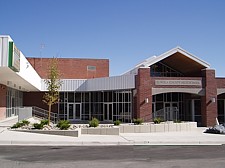Education
The Eureka County School District (ECSD) is one of the smallest districts in the state. The district operates the Eureka Elementary School and the Eureka County Junior-Senior High School in Eureka, the former with a capacity of 240 students and the latter with a capacity of 240 students; the Crescent Valley Elementary School in Crescent Valley, with a capacity of 180 students. The enrollment numbers in the Table 5-1 include a small number of students from the Duckwater Reservation in Nye County.
 In 2011, there were 239 students enrolled in Eureka County schools (Table 5-1 below). The highest school enrollment during the period 1994 to 2011 occurred in 1998 with 378 students. The lowest enrollment year occurred during in 2003, with 220 students. Figure 5-1 shows the trends in Eureka County school enrollments and Figure 5-2 shows the enrollment by grade. There are no private schools in Eureka County. High school students from Crescent Valley and Beowawe attend Battle Mountain High School. Pine Valley high school students go to Carlin High School. A former school building in Beowawe is no longer used for classes since students from Beowawe attend school in Crescent Valley, but the building is used as a manufacturing facility.
In 2011, there were 239 students enrolled in Eureka County schools (Table 5-1 below). The highest school enrollment during the period 1994 to 2011 occurred in 1998 with 378 students. The lowest enrollment year occurred during in 2003, with 220 students. Figure 5-1 shows the trends in Eureka County school enrollments and Figure 5-2 shows the enrollment by grade. There are no private schools in Eureka County. High school students from Crescent Valley and Beowawe attend Battle Mountain High School. Pine Valley high school students go to Carlin High School. A former school building in Beowawe is no longer used for classes since students from Beowawe attend school in Crescent Valley, but the building is used as a manufacturing facility.
Great Basin Community College offers classes in Eureka County by way of interactive video, making available most of the college's course offerings. Interactive video facilities in Eureka High School and Eureka and Crescent Valley Elementary Schools are used for the interactive video classes.

School District Staffing —
Table 5-2 shows the staffing levels and average salaries for teaching and non-teaching personnel in the school district. Figure 5-3 shows teaching and non-teaching staffing. As overall student enrollment in the district changes, so too has staffing. Over the last several years, staffing has increased commensurate with enrollment increases. Total staff levels were up 22 percent from 2003 to 2010. During the same period, enrollments increased from 220 to 239.

Revenue and Expenditures —
Over the period from 2006 to 2012 school district revenues increased substantially exceeding $22 million in 2011. At the same time, district expenditures have remained relatively flat ranging between $8.6 and $11 million annually. The revenues and expenditures reflect the current operating conditions where district enrollments have increased slightly with improved economic conditions in the mining sector.
Local sources make up 94 percent of school district revenue. The largest category is ad valorem taxes, which makes up over 80 percent of total local support, followed by school support taxes and a motor vehicle privilege tax. In 2004 the Eureka County voters passed a school bond measure of $6 million. The bond proceeds paid for an addition to and remodeling of the Eureka County High School. As of 2011, Eureka County School District has no debt service requirements.
Table 5-3 shows school district revenues and expenditures for the years 1995-2012. Both revenues and expenditures dropped over the 1995-2004 period. During the years 2000 to 2004 expenditures were higher than revenues. In 2005, however, revenues increased sharply while expenditures continued to drop, making school district revenues higher than expenditures for the first time in four years. That trend continues through 2012 as revenues have almost doubled annual district expenditures (Table 5-4) -- (Figure 5-4)
As shown in Table 5-4, 2012 spending for regular, vocational and other instructional programs was approximately 48 percent of overall expenditures. Undistributed expenditures, which include spending for administration, operation and maintenance of facilities, student transportation, and facilities acquisition, made up 45 percent of school expenditures. In 2011 and 2012 the district funded $2.9 and $2.6 million in building construction, respectively.
In addition to its general fund, the school district maintains several special revenue funds. One of these, the District Special Education Fund, is maintained with operating transfers from the general fund. The other special revenue account for federal or state grant revenues for programs including schools to careers, disabled education, special education aides, and others. Most funding for special education comes from these categories. The school district also maintains a Capital Projects Fund to provide for the purchase of capital assets, and a Building and Sites Fund, which was created to account for receipts from rental and sale of school property, gifts to the school district, and monies from the federal government for construction of school facilities. Expenditures from this fund are limited to constructing, remodeling or enlarging school facilities.
|

